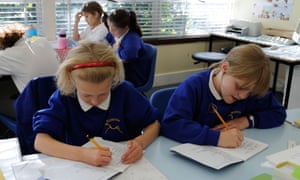
Primary schools outside of London are starting to catch up with those in the capital, according to the latest school league tables, along with a sharp drop in the number of schools failing to meet the government’s floor targets for performance.
The results of this summer’s national key stage two tests and assessments in reading, maths and writing – taken by 11-year-olds at the end of primary school – reveal an improved performance in local authorities such as Redcar and Cleveland, which were among the best performing in England.
But the top performing of all in 2015 was Kensington & Chelsea, where 91% of pupils achieved expected levels of attainment in reading, writing and mathematics, followed by Richmond-upon-Thames with 88%.
The wealthy west London borough could also boast arguably the best primary school in England, Fox Primary in Notting Hill, where the average points score achieved by its 42 pupils was bested only by the six pupils at Little Dewchurch village primary school in Herefordshire.
Redcar and Cleveland in the north-east had 87% of its pupils reach the expected levels, alongside Greenwich and Sutton, while Trafford in greater Manchester was on a par with Bromley, Camden, Hounslow and Havering with 86%.
However, the worst performing local authorities had a familiar feel, with Poole, Bradford, Doncaster, Luton, Peterborough and Walsall all in the bottom 10 for the second year in a row.
Nick Gibb, the schools minister, said it was essential that every child could leave primary school having mastered the basics in reading, writing and maths.
“The increased performance at primary level across the country demonstrates how this government is delivering on its commitment to provide educational excellence everywhere and ensure every child benefits from the best possible start in life, no matter where they come from,” Gibb said.
The Department for Education (DfE) figures showed that just 676 primary schools in England failed to meet the government’s floor target of at least 65% of pupils reaching level four or above in reading, writing and maths, compared with 768 last year after the floor standard was raised from 60%.
London had the lowest proportion of schools below the floor target, though Rutland in the East Midlands and Devon also did well, and the north-west and north-east were second only to London in the proportion of schools that performed above the floor target.
The national results published earlier this summer showed a small improvement in the number of pupils reaching the required level in literacy and maths, but that still left one in five of the nearly 580,000 pupils failing to reach the expected levels at the end of key stage two.
The improved national results confirms recent praise for primary schools by Sir Michael Wilshaw, the chief inspector of schools in England, who said the emphasis on using synthetic phonics to teach literacy was “certainly bearing fruit”, while Ofsted’s inspections showed similar patterns of performance in primary schools across the country.
The DfE said that the achievement gap between children from disadvantaged backgrounds and their better-off peers continued to narrow.
Last year there was a gap of 16 percentage points between those on free school meals achieving the government’s benchmark of level four, indicating they are ready to start secondary school, and other pupils.
The updated figures show that 80% of pupils in year six at mainstream state primary schools passed key stage two tests and assessments in reading, writing and mathematics.
The reading and maths exams were taken by 566,000 year six pupils in more than 15,000 state schools. They are the first externally marked national exams sat in England.
http://www.theguardian.com/education/2015/dec/10/primary-schools-outside-of-london-starting-to-catch-up-with-capital
http://www.theguardian.com/education/2015/dec/10/primary-schools-outside-of-london-starting-to-catch-up-with-capital

No comments:
Post a Comment